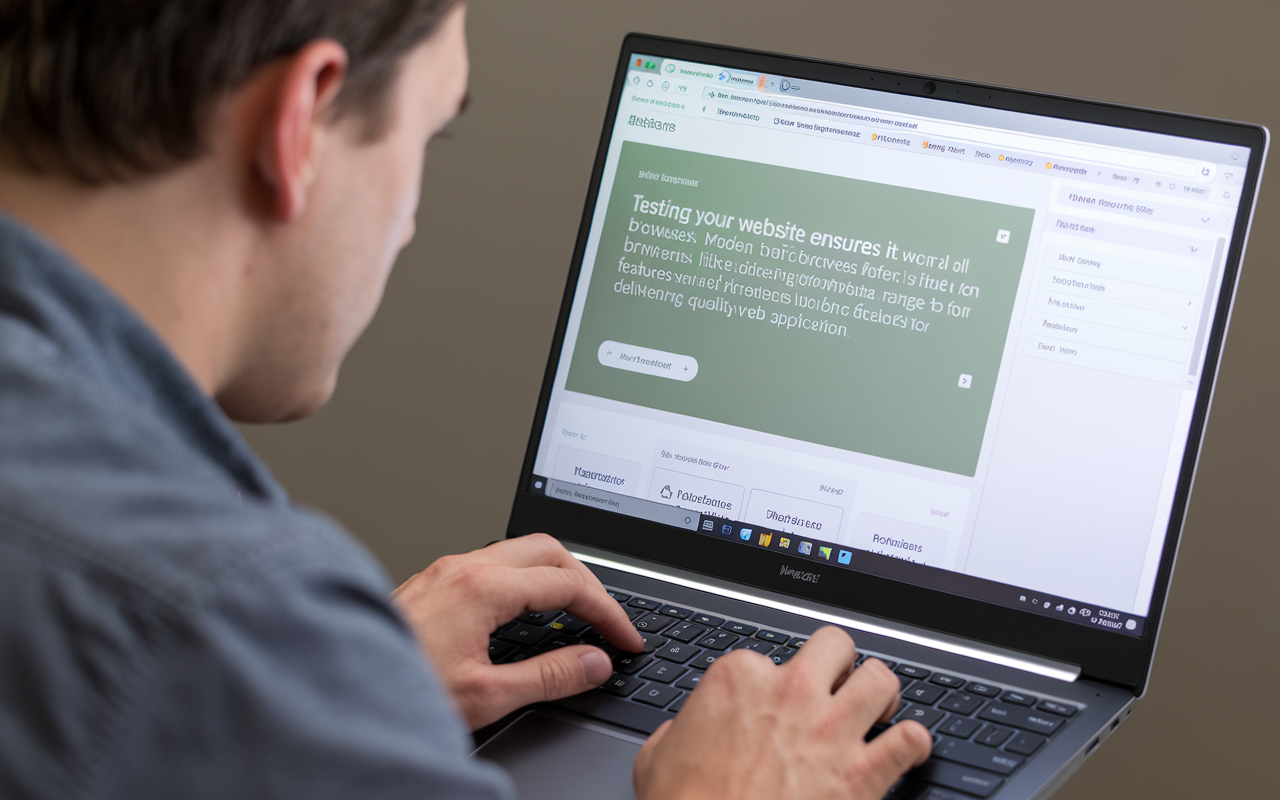Testing your website ensures it works well on all browsers. Modern browsers like Microsoft Edge Online offer a range of features to help with comprehensive web testing. Understanding modern browsers like Edge is essential for delivering a high-quality web application.
Microsoft Edge Online provides developers with a powerful platform for web testing. It supports various testing scenarios. Developers can quickly identify and resolve issues to ensure that their websites run smoothly on all devices with this tool.
Effective Strategies for Modern Web Testing Using Microsoft Edge Online
To achieve effective web testing, you need to use a variety of strategies. Each strategy helps in identifying specific issues and improving overall site quality in modern web browsers like Edge.
Cross-Browser Testing
It ensures that your website works across all the browsers. It helps you identify and fix issues related to compatibility.
- Test your website on browsers like Microsoft Edge Online to ensure consistent performance and appearance.
- Check how your website behaves on different operating systems. This helps in understanding platform-specific issues.
- Verify that your website’s layout adapts to different screen sizes. This is important for providing a consistent user experience.
- Ensure that all JavaScript functions work correctly on different browsers. Inconsistent JavaScript behavior can affect the user experience.
- Test the rendering of CSS styles across browsers. This helps in maintaining visual consistency.
- Utilize cloud testing platforms to test your site on a wide range of browsers like Microsoft Edge and Internet Explorer Online. The cloud platforms ensure comprehensive compatibility and reduce setup time.
LambdaTest is an AI-powered platform for test orchestration and execution, allowing you to conduct both manual and automated tests at scale across more than 3000 real devices, browsers, and OS combinations.
As a versatile cloud grid, it is highly regarded as one of the top cross-browser testing tools, offering support for various test automation frameworks such as Selenium, Cypress, Playwright, Appium, Espresso, and XCUITest.
You can also carry out live interactive testing within authentic browser environments. This enables you to evaluate your website or mobile application across a diverse range of Windows, macOS, Android, and iOS platforms, including both legacy and the most recent desktop and mobile browsers.
Responsive Design Testing
This process checks the adaptability of your design across various screen sizes.
- Ensure that your website adjusts to different viewport sizes. This is crucial for mobile and tablet users.
- Test the effectiveness of fluid grid layouts. This ensures that content scales properly across devices.
- Check the implementation of media queries. This allows your site to apply different styles based on screen size.
- Verify that your website is touch-friendly. This includes testing buttons, links, and interactive elements.
- Ensure that images scale correctly without losing quality. Proper image scaling improves the overall user experience.
Performance Testing
It helps you understand how well your website performs under various conditions. This process is vital for ensuring a fast and responsive user experience.
- Assess how your website handles high traffic. This ensures that your site remains responsive during peak times.
- Check your site’s loading speed. Slow speeds can make users leave and decrease satisfaction.
- Verify the effectiveness of caching mechanisms. Proper caching can significantly reduce load times.
- Check how quickly your server responds. A faster response improves user experience.
- Evaluate the impact of scripts on your website’s performance. Optimized scripts help in reducing load times.
Security Testing
It is critical for protecting your website from vulnerabilities. It helps you in identifying and addressing potential security risks in modern browsers like Microsoft Edge Online.
- Regularly scan your website for vulnerabilities. This helps find security problems early.
- Make sure your website uses SSL/TLS to keep data secure. This is important for protecting user information.
- Test your website’s access control mechanisms. Good access control stops unauthorized people from getting access to sensitive data.
- Check the strength of your encryption methods. Strong encryption helps in protecting data from being intercepted.
- Verify that your website properly validates user input. This helps in preventing common attacks like SQL injection.
Accessibility Testing
It ensures everyone, including people with disabilities, can use your website.
- Verify that all interactive elements can be accessed via the keyboard. This is crucial for users who cannot use a mouse.
- Check that all images have descriptive alt text. It lets screen perusers depict pictures to individuals who can’t see them
- Set the color contrast of your website. Good contrast helps users with visual impairments read text.
- Ensure that forms are accessible to all users. This includes proper labeling and instructions for screen reader users.
Compatibility Testing
It checks how well your website performs on different devices and environments. This process helps in identifying issues that may arise from different hardware or software configurations.
- Test your website on various devices. Verify that your site works well on different operating systems.
- Ensure that your site is compatible with different web browser versions. This helps in maintaining a consistent user experience.
- Check how your site performs on different network conditions. This includes testing on slow connections and mobile networks.
- Test your website’s compatibility with various software environments. This includes plugins, extensions, and third-party tools.
Automated Testing
It allows you to run tests quickly and efficiently. This process helps in identifying issues early in the development cycle.
- Develop test scripts for automated testing. These scripts help in running tests repeatedly without manual intervention.
- Integrate automated testing into your pipeline. This guarantees that tests are run with each code change.
- Use automated tests for regression testing. This helps in ensuring that new changes do not break existing functionality.
- Automate performance tests to monitor your site’s performance continuously. This helps in identifying performance issues early.
- Set up automated error reporting. This helps in quickly identifying and fixing issues as they arise.
Progressive Web App Testing
It ensures that your PWA performs well across different platforms.
- Test your PWA’s offline functionality. PWAs should work smoothly without an internet connection.
- Verify the functionality of push notifications. This feature is essential for user engagement.
- Ensure that your PWA provides an app-like experience. This includes smooth animations and transitions.
- Test your PWA on different platforms. This ensures consistent performance across devices and operating systems.
- Check the installation and update processes. PWAs should be easy to install and update without user intervention.
Regression Testing
It guarantees that new code changes don’t break existing usefulness. This process is vital for maintaining the stability of your website in modern browsers like Microsoft Edge Online.
- Develop a comprehensive regression test suite. This helps in covering all critical functionalities.
- Use automated tests for regression testing. This allows you to run tests frequently without manual effort.
- Integrate regression tests with version control. This ensures that tests are run for every code change.
- Track and manage bugs that arise during regression testing. Proper bug tracking helps in resolving issues quickly.
- Ensure that your regression tests cover a significant portion of your codebase. Higher code coverage reduces the risk of undetected bugs.
Usability Testing
It focuses on the user experience. This process helps in identifying areas where your website can be improved for better user satisfaction.
- Collect feedback from real users which will help understand the users interacting with your web application through a browser.
- Test how easily users can complete tasks on your site like navigating menus and filling out forms.
- Check if your website’s design is effective. A good design improves user satisfaction.
- Test how your website handles user errors. Good error handling enhances user experience.
Real-User Monitoring
It tracks the behavior of real users on your website. This process helps in understanding how users experience your site in real time.
- Monitor your website’s performance using real user data. This helps find and fix issues that slow down the site.
- Analyze how users navigate through your site. This helps in optimizing the user experience.
- Track errors encountered by real users. This aides in distinguishing and fixing issues that influence client experience.
- Monitor page load times for different users. Faster load times lead to better user satisfaction.
- Use session replay tools to watch how users interact with your site. This provides valuable insights into user behavior.
CI/CD Integration
It mechanizes the most common way of testing and sending code changes. This process helps in maintaining a consistent and reliable development workflow.
- Integrate automated tests into your pipeline. This guarantees that tests are run with each code change.
- Set up continuous monitoring to detect issues early. This helps in maintaining the stability of your website.
- Automate the deployment process. This reduces the risk of human error during deployment.
- Implement rollback mechanisms in your CI/CD pipeline. This permits you to rapidly attach back to a past variant in the event that issues emerge.
- Integrate code quality checks into your pipeline. This ensures that only quality code is deployed.
User Feedback Integration
It helps improve your website by addressing real user needs. This approach ensures that your site is practical and meets user expectations.
- Use tools like surveys, feedback forms, and user interviews to collect insights from your audience. Regular feedback helps you stay informed about user needs and preferences.
- Review the feedback to find common issues or suggestions. This analysis helps you understand what changes are necessary to improve user experience.
- Apply the improvements based on user feedback. Making these changes ensures your website evolves in a way that better serves your users.
- Verify that the changes you made work as intended. Testing ensures that the updates solve the problems identified in the feedback.
- Observe how the changes affect user satisfaction and site performance. Monitoring helps you gauge if the updates have the desired effect.
- Continue to collect feedback and make adjustments as needed. Iterating based on ongoing feedback keeps your website relevant and effective.
Conclusion
Modern web testing requires a strategic approach that covers all aspects of your website. Ensuring your website works well across different browsers like Microsoft Edge Online requires thorough testing. These methods help maintain a quality website.
Regular testing is key during development. Automation testing helps find and fix issues early to keep your website stable and secure. These effective strategies can further enhance the process and make the application adaptable to modern web browsers like Microsoft Edge Online.
Using these strategies also boosts website performance and makes the user experience better. A properly tested website is more likely to keep users engaged and achieve great success.




